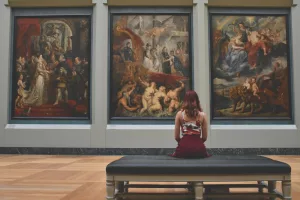Children have a natural curiosity for art in all its forms: music, movements, images, sounds … all the artistic activities which offer them a different representation of what they see in their daily life will stimulate their senses and encourage their development. As a parent, you may be asking yourself why should you introduce your child to art from an early age? What is the most appropriate art form for your child? Discover some possible answers in this article!
1. Art arouses the child’s curiosity
Children under three have a natural curiosity that has not yet been shaped by preconceptions, such as “beautiful vs ugly” or “normal vs abnormal”. They are intrigued by the discrepancies that there can be between what they know about things and what they see. Like insatiable researchers, they need to be nourished with rich and varied experiences that they will consequently seek to understand. Introducing them to various artistic activities will open their curiosity furthermore and positively shape their perception of the world around them.
From a scientific point of view, the brain activity thus stimulated by art creates neural connections that will allow the child to understand the world in its richness and complexity.
2. Artistic activities stimulate the child’s senses
Contrary to what most people might think, introducing your child to art is not primarily a learning experience for the child but a sensory experience through sounds, colors, touch that allows the young mind to discover the world. Indeed, artistic activities stimulate the child’s senses, provoke pleasure, or displeasure and arouse emotions that will help the child get to know themself better.
The child will associate a sound, a gesture, a color with their environment, their loved ones, or themself. Even more, they will identify through everything that is offered to them, what they like, what suits them or is in harmony with what they feel. And since we do not all react in the same way to a work of art, this will also allow the child to gradually differentiate themself from other individuals, with their own tastes.
Furthermore, introducing your child to art also means cultivating his or her capacities for wonder. In this artistic approach, the child will experience that reality can take different forms, that we can invent images, places, or stories. He or she will thus discover the power of thought and imagination.
3. Art allow children to connect with others
Art encourages social skills: watching, listening … together is a shared and communicative pleasure. When the parent shows a painting or plays a song to a child, even a toddler, the child will remember the happiness and the bond of this moment.
Artistic activities are opportunities for sharing and exchanging with peers or with adults. Art offers a range of means of communication with others that allows everyone to express emotions, thoughts, needs other than by speaking. It’s a way for children and adults alike to show who they are.
Artistic awakening allows children to become part of a culture with its references, its codes but also and above all to open up and discover other cultures. The more children are immersed in cultural richness from an early age, the more open they will be to diversity.
4. Art improves the child’s fine motor skills
Thanks to art, the integral development of the child improve almost without realizing it, as evidenced by this study published in Reality and Reflection. When a child is immersed in artistic activities, fine motor skills improve as their small muscles (hands and fingers) work harder. Scissor cutting, page-turning, painting, playing an instrument, etc.… all require motor coordination, which improves gradually as the child continues with the artistic activity.
This is especially true for the little ones that are still in psychomotor development. Simple things like using a brush and doodling with a pencil teach them how to use their body and mind. Early childhood specialists recommend that from the age of 3, a child should learn to draw a circle and start using scissors that adapt to their young age. By the age of four, the child should be able to draw a square and cut straight lines with scissors.
5. Art promotes language development
Good language development is also improved with arts as vocabulary increases and communication skills improve. Children can talk about what they have created. Or, if they are doing a common activity, it also improves communication with others. On the other hand, art also stimulates understanding of the environment.
6. Art promotes visual-spatial functions
Becoming familiar with drawing, painting or even sculpture helps children develop visual and spatial intelligence. With this skill, they are able to easily arrange colors, draw lines and shapes well, play with light and shadow. By getting involved in art, children will have a good spatial representation. They will have a good sense of direction, know how to estimate volume and distance. They will also have a keen eye for observation. As they grow older, they will be able to interpret, critique, and use visual information, and make choices based on it.
7. Art improves school performance
Numerous studies claim that children who practice the art of any kind perform better in school. The concentration, the application, the repetitions that an artistic work requires, have a lot to do with it. These good practices and good attitudes will gradually become second nature to children, and they will apply them in all areas of their lives.
8. Art broadens the child’s interests
Art also teaches them to appreciate other things that give them a sense of well-being through creativity. Children today are excessively immersed in the digital world, and it numbs their imagination and creativity. This is why it is so important to promote arts activities at home because they benefit from it and their minds work much better.
9. Art promotes problem-solving skills
To have good problem-solving skills, it is important to improve critical thinking, and this is also done through art. Young children learn to think constructively about what they are doing. If they make a mistake, they look for ways to fix it or ask for help if needed. Furthermore, the choice of the subject to draw, the choice of colors to use… These may be small things, but they will gradually help to build the child’s reasoning. Since the artwork will is the child’s own creation, only they can decide what to do to make their imagination come true.
10. Art develops patience and perseverance in children
Being good at an art form doesn’t happen overnight; it takes time to become an accomplished artist. So, there might be times of discouragement, the child might be tempted to give up. But when you truly practice an art that you enjoy, patience and persistence always pay off. Getting a child to adopt this mindset is very important because as they grow up, they will always be faced with situations that will require a lot of patience.
11. Art teaches children how to set goals
Learning a form of art, be it painting, drawing, or any other artistic works requires defining certain goals. To achieve these goals, we must proceed in stages. To draw a portrait, for example, the child will start with the oval of the head before adding all the details. You don’t just draw anyhow; you have to put in place a strategy. In this way, artistic activities provide to the child real-life lessons that will serve them greatly in adulthood.
12. Art promotes introspection in children
Art helps children think about themselves. They will focus more on themselves externally and internally. They can make parts of the body with plasticine or draw themselves. Likewise, they become aware of themselves on many different levels, for example at the physical and emotional levels.
13. Art promotes collaboration and accountability in children
Some artistic achievements require children to work together. They must share the responsibility to achieve a common goal. In this way, children learn that their contribution to the group is integral to their success. This is another life lesson that a child can apply in other areas of their life as they grow older.
14. Art teaches kids how to correct mistakes
Through art, children realize that mistakes are a part of life, so you have to learn to accept them, correct them and move on. Indeed, no child will ever succeed perfectly in an artistic work, the first time. They will have to grope, erase, align… Sometimes they will even have to start all over from the beginning, frustrating but this is necessary. The sooner the child learns to accept that everyone can make mistakes, the sooner they will learn to correct them when they happen. Involving the child in an art workshop is a very good way to achieve this result.



